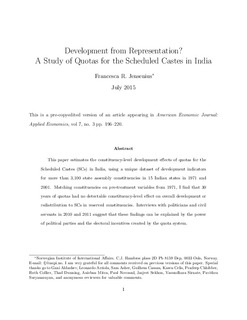| dc.contributor.author | Jensenius, Francesca R. | |
| dc.date.accessioned | 2016-01-29T15:45:28Z | |
| dc.date.accessioned | 2016-02-22T09:52:29Z | |
| dc.date.available | 2016-01-29T15:45:28Z | |
| dc.date.available | 2016-02-22T09:52:29Z | |
| dc.date.issued | 2015 | |
| dc.identifier.citation | American Economic Journal: Applied Economics 2015, 7(3):196-220 | nb_NO |
| dc.identifier.issn | 1945-7790 | |
| dc.identifier.uri | http://hdl.handle.net/11250/2379869 | |
| dc.description | - | nb_NO |
| dc.description.abstract | This paper estimates the constituency-level development effects of quotas for the Scheduled Castes (SCs) in India, using a unique dataset of development indicators for more than 3,100 state assembly constituencies in 15 Indian states in 1971 and 2001. Matching constituencies on pretreatment variables from 1971, I find that 30 years of quotas had no detectable constituency-level effect on overall development or redistribution to SCs. Interviews with politicians and civil servants in 2010 and 2011 suggest that these findings can be explained by the power of political parties and the electoral incentives created by the quota system. | nb_NO |
| dc.language.iso | eng | nb_NO |
| dc.publisher | American Economic Association | nb_NO |
| dc.relation.uri | http://www.francesca.no/wp-content/2015/12/Development_reservations_postprint.pdf | |
| dc.title | Development from representation? A study of quotas for the scheduled castes in India | nb_NO |
| dc.type | Journal article | nb_NO |
| dc.type | Peer reviewed | |
| dc.date.updated | 2016-01-29T15:45:28Z | |
| dc.identifier.doi | 10.1257/app.20140201 | |
| dc.identifier.cristin | 1251406 | |
| dc.relation.project | Norges forskningsråd: 225905 | nb_NO |
